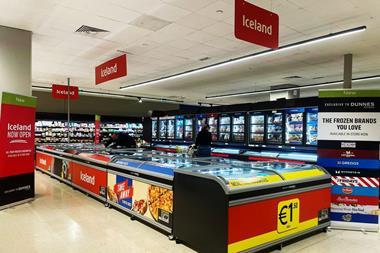Career: Between 1991 and 1996 he was a buyer at Sainsbury, with stints as a pork buyer and senior manager for beers, spirits and soft drinks. With Diageo since 1996 in senior roles including MD of Guinness GB and president (North America) South West.
He has arguably landed one of the toughest jobs in grocery retailing. But Stephen Nelson loves a challenge. Julian Hunt reports
Age: 40
Key strengths: Learned much about leadership and customer service at Diageo and, of course, he understands life from the suppliers’ side. A challenge will be managing teams that have been through a tough head office restructure. “Morale is never high during significant change programmes but I can raise morale by good communications and good leadership.”
Home: Married with two children aged six and four
A 48-hour, non-stop bicycle race through California’s Death Valley doesn’t sound like a lot of fun. But it’s the sort of thing that gives Stephen Nelson a buzz, which is why he is taking part in next month’s Furnace Creek 508 ultramarathon race - an ordeal for which he is preparing by doing a 100-mile ride every Saturday. Clearly this is a man who really means it when he says he likes a challenge - which is just as well as many would argue that Nelson has taken on one of the toughest buying jobs in the business.
Not surprisingly Nelson, who rejoined Sainsbury as its new trading director just eight weeks ago, doesn’t see it that way. “What enticed me back was the fact that this is a company with huge potential. I had seen the necessary investment was being made in the infrastructure and stores and I already knew the brand’s potential,” he says.
Last week, at Sainsbury’s annual supplier conference, Nelson and the chain’s other top brass outlined how they were going to realise that potential in what they called “the year of delivery”. It’s going to be tough. Most observers feel Sainsbury has entered its own Death Valley - caught somewhere in the middle of the EDLP players and the quality-focused niche operators - and they struggle to see how it is going to trade its way out of trouble.
As far as Nelson is concerned the strategy for rebuilding sales is simple enough to explain: he wants the business to focus on growth areas and quality, delivering against customer needs and expectations in both.
The growth side of that equation is all about innovating by spotting and exploiting consumer trends better than the opposition. Nelson rattles off a list of opportunities that he says are “well identified but not well served”, such as the growing demand for meal solutions, the boom in products with a health function or meeting the diverse needs of the ‘can’t cook, won’t cook’ generation.
“It’s my job to motivate traders to deliver against these customer needs” Nelson says.
“Quality will be the second part of our mantra,” he adds. “Sainsbury has an historic legacy of leadership in this and we have got great foundations to lead again on food and non-food quality for the mass market. We are a scale player and there’s no sense in which Sainsbury can serve anything other than a wide range of customers.”
But that has meant redefining exactly what quality means for Sainsbury and its shoppers - a process that has proved controversial. Last month The Grocer revealed supplier concerns that the retailer was downgrading quality to compete on price with Tesco and Asda. Nelson insists nothing could be further from the truth, and that Sainsbury is simply aiming for the right quality at the right price. “It’s not quality for quality’s sake,” he says.
He explains: “On occasion products have been over-engineered. There are plenty of opportunities for serving the needs of customers better - provided we do exactly that. The skill is not always asking them to pay more for that. There’s a time when people will. But the battleground for us is in standard and standard plus ranges where, through a deep understanding of customers’ needs and supplier relationships, we can deliver against people’s expectations better than the competition.”
You can see where Nelson is coming from. But it is just as easy to understand why suppliers have been so concerned - particularly as many of the changes have been born out of Sainsbury’s controversial PICO open book initiative.
The PICO project is all about cutting costs. So how does Nelson square that with his “growth and quality” mantra? “PICO did not try to strategically reduce quality,” he insists. Instead, he explains, it was all about ensuring Sainsbury was buying as efficiently as possible and had the most effective relationships with suppliers. And even though that has put some suppliers at the wrong end of some tough decisions, Nelson says Sainsbury should make no apologies for such a strong focus on costs in the early days of its recovery programme.
“I do not expect us to take our foot off the cost pedal,” he continues. “Now is the time to go after growth while maintaining good cost efficiencies. All of our competitors are driving cost from their businesses and we must be as determined as them to pursue that.”
For instance, he has made it clear that Sainsbury will push hard with online auctions where relevant, which will not be welcomed with open arms by many suppliers.
Nevertheless, Nelson is keen to shift the talk away from cost, while accepting there is still some way to go in changing the culture of the trading division so it focuses on growth and has a consumer-led mindset. But he told suppliers at last week’s conference they needed to come on board as well to help the chain build progressive relationships. “The growth and quality direction will not be delivered unless we work well together.”
Suppliers at the conference also heard that, as part of its efforts to foster more effective co-operation, Sainsbury was getting some of the basics right, such as fixing its invoicing systems, encouraging buying teams to have joint business plans with suppliers, having a better internal category focus and ensuring ranges were more relevant with line reductions where appropriate.
And, Nelson assured suppliers, they would be asked to support fewer, better, “not just deeper” promotions.
He disagrees with the notion that whenever Sainsbury turns down its promotional noise it turns off consumers who have got accustomed to shopping in a price-driven retail environment. Instead, he says, shoppers will be turned on by smarter in-store activity.
“There is a lot we can do to clarify our offer by reducing inefficient promotions. A high proportion of promotions do not deliver incremental growth of sales, or profit, or the clarity the customer needs when shopping a section. We will address that by taking down the number of promotions by 25% through a smarter mix of activity and by understanding where we are promoting items with expandable consumption and where we are not.”
While all the elements are in place, an obvious question remains: will it all be enough to deliver the sales uplift Sainsbury needs? “The shift required to generate further growth is not a 90 degree shift,” says Nelson. “It is a 10 to 15 degree shift in people’s expectations and how we deliver. While that’s not an overnight task it is the reason why I am greatly encouraged.”
But it’s not going to be a soft ride - even for someone with the grit and determination to race a bicycle through California’s infamous Death Valley.
He has arguably landed one of the toughest jobs in grocery retailing. But Stephen Nelson loves a challenge. Julian Hunt reports
Age: 40
Key strengths: Learned much about leadership and customer service at Diageo and, of course, he understands life from the suppliers’ side. A challenge will be managing teams that have been through a tough head office restructure. “Morale is never high during significant change programmes but I can raise morale by good communications and good leadership.”
Home: Married with two children aged six and four
A 48-hour, non-stop bicycle race through California’s Death Valley doesn’t sound like a lot of fun. But it’s the sort of thing that gives Stephen Nelson a buzz, which is why he is taking part in next month’s Furnace Creek 508 ultramarathon race - an ordeal for which he is preparing by doing a 100-mile ride every Saturday. Clearly this is a man who really means it when he says he likes a challenge - which is just as well as many would argue that Nelson has taken on one of the toughest buying jobs in the business.
Not surprisingly Nelson, who rejoined Sainsbury as its new trading director just eight weeks ago, doesn’t see it that way. “What enticed me back was the fact that this is a company with huge potential. I had seen the necessary investment was being made in the infrastructure and stores and I already knew the brand’s potential,” he says.
Last week, at Sainsbury’s annual supplier conference, Nelson and the chain’s other top brass outlined how they were going to realise that potential in what they called “the year of delivery”. It’s going to be tough. Most observers feel Sainsbury has entered its own Death Valley - caught somewhere in the middle of the EDLP players and the quality-focused niche operators - and they struggle to see how it is going to trade its way out of trouble.
As far as Nelson is concerned the strategy for rebuilding sales is simple enough to explain: he wants the business to focus on growth areas and quality, delivering against customer needs and expectations in both.
The growth side of that equation is all about innovating by spotting and exploiting consumer trends better than the opposition. Nelson rattles off a list of opportunities that he says are “well identified but not well served”, such as the growing demand for meal solutions, the boom in products with a health function or meeting the diverse needs of the ‘can’t cook, won’t cook’ generation.
“It’s my job to motivate traders to deliver against these customer needs” Nelson says.
“Quality will be the second part of our mantra,” he adds. “Sainsbury has an historic legacy of leadership in this and we have got great foundations to lead again on food and non-food quality for the mass market. We are a scale player and there’s no sense in which Sainsbury can serve anything other than a wide range of customers.”
But that has meant redefining exactly what quality means for Sainsbury and its shoppers - a process that has proved controversial. Last month The Grocer revealed supplier concerns that the retailer was downgrading quality to compete on price with Tesco and Asda. Nelson insists nothing could be further from the truth, and that Sainsbury is simply aiming for the right quality at the right price. “It’s not quality for quality’s sake,” he says.
He explains: “On occasion products have been over-engineered. There are plenty of opportunities for serving the needs of customers better - provided we do exactly that. The skill is not always asking them to pay more for that. There’s a time when people will. But the battleground for us is in standard and standard plus ranges where, through a deep understanding of customers’ needs and supplier relationships, we can deliver against people’s expectations better than the competition.”
You can see where Nelson is coming from. But it is just as easy to understand why suppliers have been so concerned - particularly as many of the changes have been born out of Sainsbury’s controversial PICO open book initiative.
The PICO project is all about cutting costs. So how does Nelson square that with his “growth and quality” mantra? “PICO did not try to strategically reduce quality,” he insists. Instead, he explains, it was all about ensuring Sainsbury was buying as efficiently as possible and had the most effective relationships with suppliers. And even though that has put some suppliers at the wrong end of some tough decisions, Nelson says Sainsbury should make no apologies for such a strong focus on costs in the early days of its recovery programme.
“I do not expect us to take our foot off the cost pedal,” he continues. “Now is the time to go after growth while maintaining good cost efficiencies. All of our competitors are driving cost from their businesses and we must be as determined as them to pursue that.”
For instance, he has made it clear that Sainsbury will push hard with online auctions where relevant, which will not be welcomed with open arms by many suppliers.
Nevertheless, Nelson is keen to shift the talk away from cost, while accepting there is still some way to go in changing the culture of the trading division so it focuses on growth and has a consumer-led mindset. But he told suppliers at last week’s conference they needed to come on board as well to help the chain build progressive relationships. “The growth and quality direction will not be delivered unless we work well together.”
Suppliers at the conference also heard that, as part of its efforts to foster more effective co-operation, Sainsbury was getting some of the basics right, such as fixing its invoicing systems, encouraging buying teams to have joint business plans with suppliers, having a better internal category focus and ensuring ranges were more relevant with line reductions where appropriate.
And, Nelson assured suppliers, they would be asked to support fewer, better, “not just deeper” promotions.
He disagrees with the notion that whenever Sainsbury turns down its promotional noise it turns off consumers who have got accustomed to shopping in a price-driven retail environment. Instead, he says, shoppers will be turned on by smarter in-store activity.
“There is a lot we can do to clarify our offer by reducing inefficient promotions. A high proportion of promotions do not deliver incremental growth of sales, or profit, or the clarity the customer needs when shopping a section. We will address that by taking down the number of promotions by 25% through a smarter mix of activity and by understanding where we are promoting items with expandable consumption and where we are not.”
While all the elements are in place, an obvious question remains: will it all be enough to deliver the sales uplift Sainsbury needs? “The shift required to generate further growth is not a 90 degree shift,” says Nelson. “It is a 10 to 15 degree shift in people’s expectations and how we deliver. While that’s not an overnight task it is the reason why I am greatly encouraged.”
But it’s not going to be a soft ride - even for someone with the grit and determination to race a bicycle through California’s infamous Death Valley.



















No comments yet